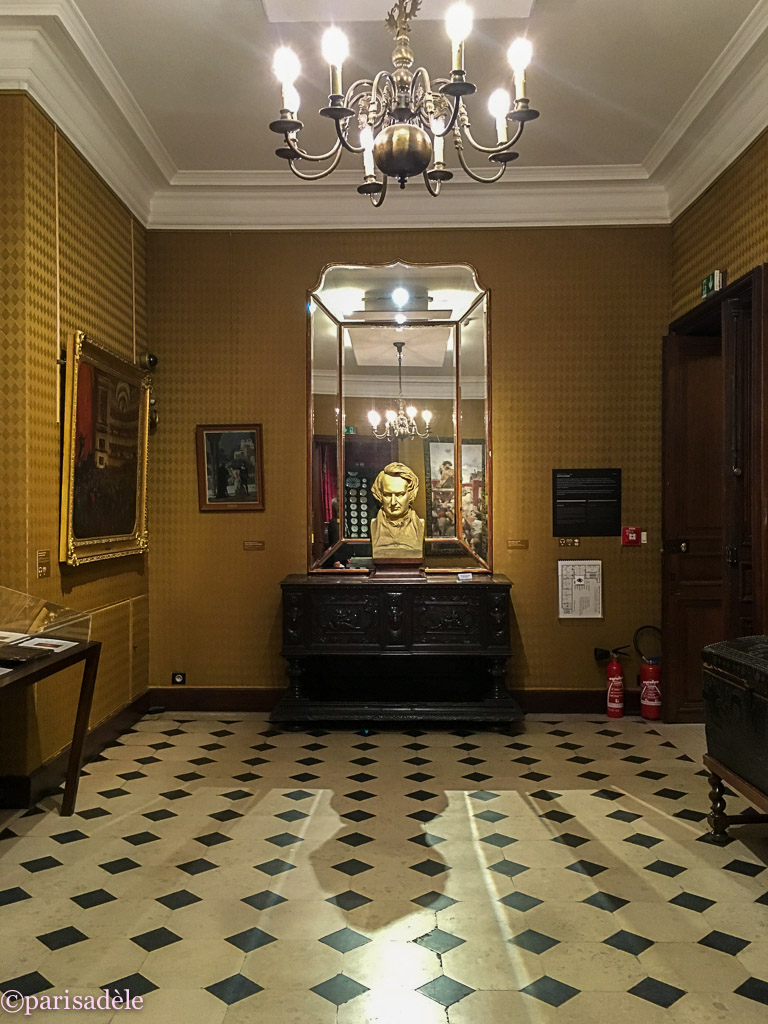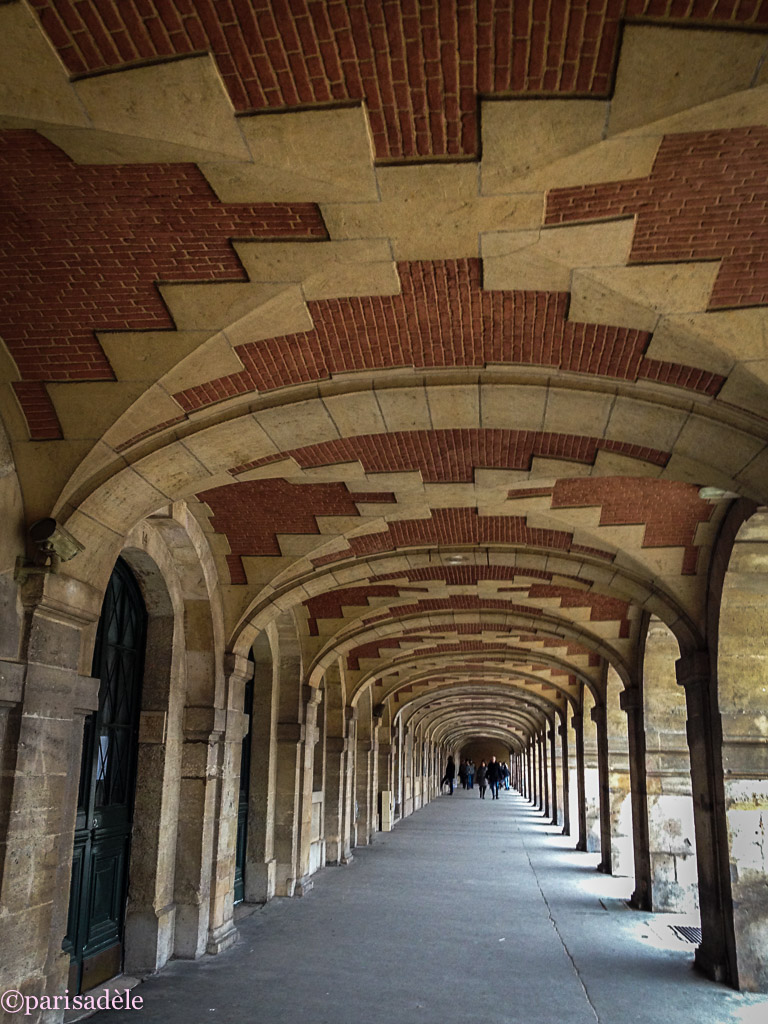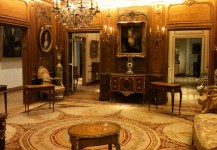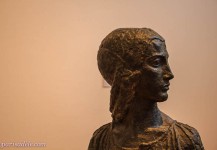Maison de Victor Hugo
Tucked away in the south-eastern corner of the elegant and oldest planned square in Paris; Place des Vosges you will find the former home of author and poet Victor Hugo.
Renowned for his novels Les Miserables and Notre Dame de Paris; or better known in English as The Hunchback of Notre Dame.
Climbing the stairs to the 2nd floor of the Hôtel de Rohan-Guéménée you will arrive at the understated antechamber. The sparsely decorated room with black and white tiles adorning the floors is just an entrée to a riot of colour that awaits.
Red Damask wallpaper and heavy matching velvet draps creates a lush backdrop for some stunning pieces of art that line the walls.
But everything is not as it seems. Archicad price
Although the 30 year old Victor Hugo and his wife Adèle Foucher moved here in 1832 one year after the publication of The Hunchback of Notre Dame and resided here until 1848, his private residence has been reconstructed from a collection of recovered pieces from various homes he lived in over the years.
The man responsible for offering a large donation and instigating Maison de Victor Hugo in 1902 was Paul Meurice.
Meurice was only 18 when he met Victor Hugo and a great and long lasting friendship was forged. It was Meurice together with Hugo’s son Charles who brought the play Les Misérables to the stage.
Victor Hugo was a man ahead of his time.
Today it is considered fashionable to work from a standing position at a high desk but this was Hugo’s preferred method to write and the evidence is here. The desk where he crafted words into memorable novels and poems.
Not only was Victor Hugo one of the greatest writers of his time but he also enjoyed drawing and interior design.
This Asian inspired room recreated from his time in exile displays his collection of Asian artefacts, porcelain and furniture that he helped design and paint.
A lot of care and attention has gone into recreating the life of Victor Hugo, in this small 7 room museum, offering us a glimpse of a very complex man.
A man who wouldn’t marry his childhood sweetheart until after his disapproving mother’s death. A man who was artistic and gifted but also political and stood tall and firm for what he believed in.
But also a man who was filled with great despair after the accidental drowning of his 19 year old daughter Léopoldine and her husband Charles Vacquerie who died in vain trying to save her. Their precious lives cut short only 7 months after their wedding.
The smallest room in the house, decorated in plush red velvet and the most sombre is that of Victor Hugo’s Bedroom.
The carved timber, four poster bed in which he died in 1843 was donated to the museum by his grandchildren.
I suggest, if you can to wait until the small crowds that populate the room disperse, so you can have some quiet time in the dimly lit room.
Before you leave the museum peel back the heavy velvet drapes and peer out the window to admire the spectacular view that afforded Victor Hugo of the central garden of the colonnaded square.
Before Place des Vosges was instigated by Henri IV, it was on this site where Henri II died during a tournament and prompted Catherine de Medicis to demolish the then Hotel des Tournelles.
Later in 1612, to much fanfare for the wedding of Louis XIII and Anne of Austria Place des Vosges was inaugurated and would become the inspiration for architecture across Europe.
If you have found this useful or interesting, please leave a comment or follow me here on facebook for daily tips, photos and anecdotes. Your feedback encourages me to keep this site up to date. Merci!
Paris Adèle’s Information Necessaire:
Maison de Victor Hugo – Official Website
6 place des Vosges
75004 Paris – MAP
Opening Hours:
Tuesday – Sunday
10am to 6pm
Nearest Metro:
Saint-Paul or Bastille
Entrance: Free to permanent exhibitions
Disabled Access: Yes – check website for further information
Cafés, Museums, Markets and Shopping Nearby:
- Petit Fer a ChevalThis charming, historic bar in the 4th arrondissement and the heart of the Marais, is my all time favourite. Great food, full of character and friendly staff.
- Bastille MarketsThe Bastille Markets are everything you could hope for in a typical Parisian Market; vibrant, colourful, delicious and intoxicating.
- MerciSitting at the end of a cobbled lane-way, is a tiny red car with the number plate; Merci. You have just arrived at the stylish and innovative concept store.
- Musée Cognacq-JayThis stunning home of Samaritaine Department store founder, Ernest Cognacq-Jay and his wife Marie-Louise Jay, includes Fragonard, Rembrandt, Cézanne ...
- Musée de la Chasse et de la NatureThis wonderfully, quirky, informative, interactive museum, doesn't take itself too seriously. Exploring the history of hunting.
- Musée CarnavaletLocated in the heart of the Marais, this museum is dedicated to the history of Paris. Boasting 600,000 pieces, ranging from the 17th to 20th centuries.
More Free Museums:
- Maison de Victor HugoNestled in a corner of Place des Vosges, is the former home of famous author of the Hunchback of Notre Dame; Victor Hugo.
- Musée de la Vie RomantiqueTucked away behind an unassuming green gate, you will discover this enchanting hôtel particulier. An absolute delight.
- Petit PalaisNot as small as its name suggests. Elaborate ceiling murals, magnificent mosaics, grand staircases a pretty garden café and it is free.
- Musée Cognacq-JayThis stunning home of Samaritaine Department store founder, Ernest Cognacq-Jay and his wife Marie-Louise Jay, includes Fragonard, Rembrandt, Cézanne ...
- Musée BourdelleFormer home and studio of the artist; Antoine Bourdelle, who was famous for his monumental public statues and friezes, is an exceptional free museum.
- Musée ZadkineThe small sun drenched former home of Ossip Zadkine allow light to bounce off African influenced work, giving the museum a quiet sense of calm and elegance.
- Musée CarnavaletLocated in the heart of the Marais, this museum is dedicated to the history of Paris. Boasting 600,000 pieces, ranging from the 17th to 20th centuries.






















